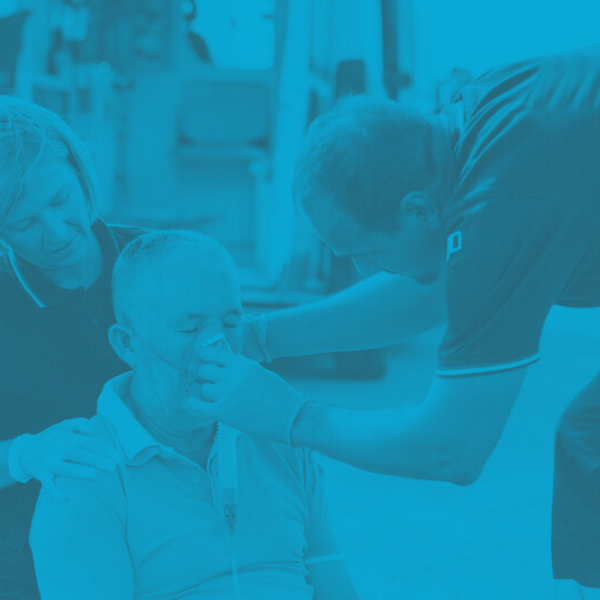Code Red Hospital Training: What You Need to Know
Code Red Hospital Training: What You Need to Know

by Greta Kviklyte
Life Saver, AMC
Co-authored by Kim Murray, RN, M.S.
posted on May 27, 2021, at 7:58 am
If you work in a hospital, code red may be part of your workday at some point. When these emergencies occur, you want to be as useful as possible in order to reduce the impact on the hospital, patients and visitors. For this reason, it is important to understand what this code means, as well as the proper response.
What Is a Code Red?
A code red is announced when there is reason to believe that a fire emergency is present within the building. For example, a staff member or visitor to the hospital may see smoke, smell smoke or see flames. Someone may also report a possible fire if doors or walls in the hospital feel hot when touched.
We offer Online ACLS, PALS and BLS Certification and Renewal
 Typically, the code red will be announced within a specific location to let responders know where the threat is suspected. For example, the announcer may say “code red ER” or “code red surgery unit.” If the hospital has the appropriate technology, staff members may even receive an alert on their phones or other mobile devices before the announcement is made throughout the hospital.
Typically, the code red will be announced within a specific location to let responders know where the threat is suspected. For example, the announcer may say “code red ER” or “code red surgery unit.” If the hospital has the appropriate technology, staff members may even receive an alert on their phones or other mobile devices before the announcement is made throughout the hospital.
What Do Staff Members Do During a Code Red?
During a code red, hospital staff will have different responsibilities depending on their position. Some members of the staff will be working to move patients who are vulnerable to the fire to safe locations. Other staff members may be responsible for assessing patient’s injuries, including traumas, burns and smoke inhalation. All staff members will be responsible for remaining calm and preventing people in the hospital from panicking.
Why Is Code Red Hospital Training Necessary?
Although a staff member’s responsibilities during a code red may seem straightforward, dealing with this situation can be stressful and overwhelming. Code red hospital training ensures that you have all the knowledge, skills and resources you need to perform efficiently and effectively under the stress of a code red.
Code red hospital training can come in different forms. In order to perform at your best during a code red, you may choose to obtain Basic Life Support certification, Advanced Cardiac Life Support certification and/or Pediatric Advanced Life Support certification. In many cases, one or more of these certifications may be required by your employer. However, even if certification is not required, it is still a good idea for all hospital workers to have at least basic life support skills. At the bare minimum, personnel working in a hospital should understand basic CPR and first aid so they can be useful in the event of a code red.
Some of the specific benefits of obtaining a life support certification or learning to provide basic first aid include:
- A more competitive job application, which gives you a better chance of getting the job you want even when other people are applying.
- A better chance of qualifying for a raise or a promotion within your current organization.
- Enhanced, detailed knowledge that can be used to help people and protect against panic during a fire.
- The confidence you need to be useful during a code red hospital emergency.
What Type of Code Red Hospital Training Is Best?
The type of code red hospital training you need will depend on many factors, including your exact position, your employer’s requirements and your goals as an employee. If you are a healthcare professional, chances are that you will need to obtain one or more certifications in order to meet the requirements of your employment. However, if you are non-medical hospital personnel, these certifications may not be required.
Nonetheless, even if you are not a healthcare professional, you can still benefit from code red hospital training. You may consider learning to perform CPR, learning about first aid and/or obtaining a Basic Life Support certification. You may also choose to learn how to use an automated external defibrillator to revive patients in cardiac arrest.
About Code Red Hospital Training Programs
The specific skills you will learn in a code red hospital training program will depend on the program you choose.
CPR, AED & First Aid Certification
CPR, AED & First Aid Certification courses are designed to prepare you for various emergencies that can occur in the hospital, especially during a code red situation. After completing this program, you will have the knowledge and skills needed to provide first-line treatment for:
- Strokes
- Seizures
- Neck or spine injuries
- Contact with dangerous chemicals
- Smoke or chemical fume inhalation
- Bleeding
- Choking
- Burns
- Asthma attacks
- Food allergy attacks
- Diabetic comas
- Cardiac arrest
Bloodborne Pathogens Training
During a code red hospital emergency, patients may have sustained injuries that involve bleeding. For this reason, bloodborne pathogens training is often recommended for medical and non-medical personnel who may encounter a code red in the hospital.
The purpose of bloodborne pathogens training is to teach hospital personnel how to handle blood that may be infected with dangerous pathogens, such as HIV, Hepatitis B and Hepatitis C. If you take a bloodborne pathogens training course, you will learn about:
- The basics of bloodborne pathogen transmission.
- Vaccines that prevent infection from bloodborne pathogens.
- Responding to bloodborne pathogen exposures.
- Using personal protective equipment appropriately.
- Cleaning up in an area that may be contaminated with bloodborne pathogens.
- Recognizing bloodborne pathogen exposure risks
- Reducing the risk of exposure to bloodborne pathogens.
Basic Life Support Certification
Basic Life Support certification courses are designed to teach medical and non-medical personnel how to respond effectively when someone is in cardiac arrest, respiratory arrest or a similar state. All of these situations call for an immediate response in order to give the patient the best chance of survival, so it is wise for any hospital staff member to understand basic life support principles in case of a code red or similar emergency.
Basic Life Support certification courses will teach you how to:
- Perform chest compressions and rescue breathing (CPR).
- Clear the patient’s airway in the case of choking or a blockage
- Use an automated external defibrillator appropriately.
Advanced Cardiac Life Support Certification
Studies have shown that Advanced Cardiac Life Support training can improve patient survival rates. Code red situations increase the chances of cardiac arrest and similar situations, so hospital staff can benefit from this type of training.
Advanced Cardiac Life Support training is more advanced than Basic Life Support training, which means you will need to complete your BLS training course first. Some of the skills you will learn in ACLS training programs include:
- How to properly identify a patient in respiratory or cardiac distress.
- How to manage patients who are in respiratory distress or cardiac arrest.
- How to identify heart-related complications that could be more likely during a code red situation.
- How to open and maintain an airway.
- How to administer medications to patients with cardiac or respiratory issues.
- How to help a patient during or after a stroke.
- How to communicate with other team members while supporting a patient in respiratory distress or cardiac arrest.
Although ACLS training programs often review the concepts covered during BLS training, this course is not a substitute for BLS training and should be taken after you have successfully obtained your BLS certification.
Pediatric Advanced Life Support Certification
Pediatric patients present unique challenges when it comes to providing life support services. Because of their smaller bodies and other unique characteristics, a different set of skills is needed to effectively provide life support to a child or infant.
Pediatric Advanced Life Support, or PALS, is intended to train both medical and non-medical personnel to manage pediatric patients who experience cardiac arrest. As with cardiac events in adults, cardiac arrest in pediatric patients is more likely to occur when a code red situation arises.
During your PALS certification course, you will learn:
- How to resuscitate a pediatric patient at different ages.
- How to use tools in the resuscitation of pediatric patients.
- How to resuscitate pediatric patients when working with a team.
Basic Code Red Response
 When a code red emergency arises in the hospital, providing first aid and life support is only part of the response process. In fact, the immediate reaction to a code red won’t always involve life support or first aid. To help both medical and non-medical personnel respond to a code red emergency, many hospitals institute the RACE procedure.
When a code red emergency arises in the hospital, providing first aid and life support is only part of the response process. In fact, the immediate reaction to a code red won’t always involve life support or first aid. To help both medical and non-medical personnel respond to a code red emergency, many hospitals institute the RACE procedure.
The first instruction in this procedure is Rescue. Personnel are instructed to help all people who are in immediate danger. For example, personnel may need to move patients out of harm’s way or provide first aid to patients in critical condition because of the fire.
The second instruction in the procedure is Alarm. During this step, hospital personnel should sound the alarm to alert everyone in the hospital of the situation.
The third instruction in the procedure is Confine. Hospital personnel are instructed to close off doors that can be easily accessed in order to slow down the spread of the fire.
The final instruction in this procedure is Extinguish. Hospital personnel should use fire extinguishers to put out the fire if doing so is reasonable.
Code Red Training for Employers
Hospital employees may decide to get the training they need to properly respond to a code red on their own. However, if you own or operate a hospital, the best thing you can do to ensure that every employee has the skills they need to respond to a fire is to institute a team-based code red training program for all of your employees.
A code red training program ensures that every person on your staff knows how to provide basic life support services and help patients in the event of a fire, even if they are not licensed medical professionals. This can dramatically improve outcomes when a fire occurs, saving your hospital money and reducing loss of life.
Getting the Training You Need
If you work in a hospital or a similar facility, having code red training is highly recommended. Code red training will ensure that you are able to respond properly and potentially save lives in the event of a fire.
After you have decided what type of training will be best for your needs, the next step involves choosing the best program. Different types of training programs are available to meet the needs of a variety of students. Training programs may be conducted over the internet, in person or in a hybrid format that combines both in-person and online instruction.
Although each type of instruction offers different advantages, many hospital personnel now choose to obtain the training they need online. Online programs are convenient, allowing you to study the course materials on your own time at a pace that works for you. With an online program, you can also obtain your certification without traveling.
Advanced Medical Certification is proud to offer a full menu of certification and training options for students who want to be prepared for the possibility of a code red. We offer ACLS, PALS and BLS training, as well as a basic CPR, AED & First Aid course. We also offer Bloodborne Pathogens training. Depending on your situation and goals, you may need to complete just one of these programs, or you may need to complete more than one. All of our programs include an online exam and a digital certification card that will be made available immediately after passing the course. Please contact Advanced Medical Certification today to learn more about our courses or to sign up for a program.
Have you ever experienced a code silver in a hospital? Tell your story.




This post was really informative! I had no idea about the specific procedures involved in Code Red situations. It’s crucial for every healthcare worker to be prepared, and your tips are super helpful. Thanks for shedding light on this important topic!
Thank you so much for your kind words! We’re thrilled to hear that you found the information on Code Red procedures helpful. Preparedness in healthcare settings is indeed crucial, and knowing these procedures can make all the difference in ensuring safety for everyone involved. If you have any other questions or if there are other topics you’d like us to cover, please let us know. We’re always here to help!
This post is incredibly informative! I appreciated the clarity on the protocols and the importance of teamwork during Code Red situations. It’s crucial for all hospital staff to be prepared, and your tips will definitely help in training. Thanks for sharing!
Glad you found the post helpful and that the clarity on protocols and teamwork for Code Red situations will aid in staff training. Thanks for your feedback!